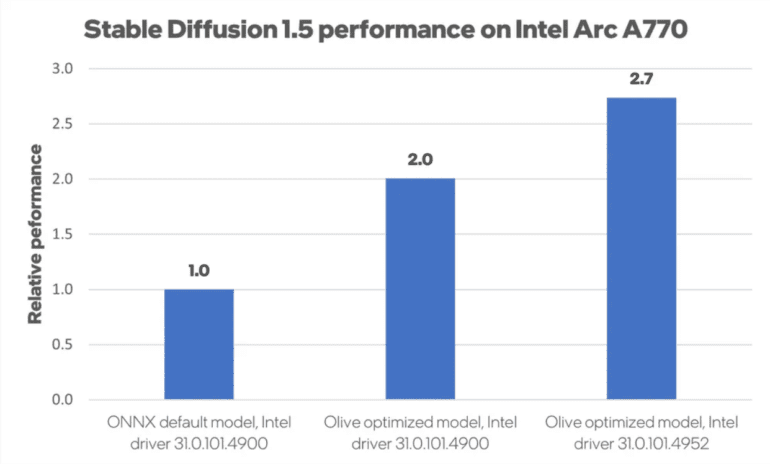TL;DR:
- Intel’s latest GPU drivers deliver a significant 2.7X performance boost in AI-driven Stable Diffusion.
- Microsoft Olive, an AI optimization tool, played a crucial role in this achievement.
- Intel’s Xe Matrix Extensions (XMX) cores, similar to Nvidia’s Tensor cores, were underutilized until Olive’s integration.
- Additional performance gains were achieved through Intel’s model optimizations.
- Nvidia also used Olive to double its GPU performance for Stable Diffusion.
- AMD’s RDNA 3 graphics cards show promise in AI tasks, hinting at future optimization potential.
- The market is witnessing a race for AI optimization, with Olive as a key player.
Main AI News:
In the world of cutting-edge technology, where performance is paramount, Intel’s latest Arc Alchemist GPU drivers have taken a giant leap forward, delivering a jaw-dropping 2.7X boost in AI-driven Stable Diffusion. While the Intel driver team’s expertise in optimization is well-known, this remarkable achievement owes much of its success to Microsoft’s innovative tool, Olive.
Microsoft Olive, a sophisticated piece of software, acts as a catalyst for AI and machine learning models, uncovering the untapped potential of various hardware configurations. Without a doubt, optimizing AI applications is a complex task, considering the diverse range of AI hardware available from different manufacturers. However, Microsoft Olive simplifies this intricate process significantly.
Intel’s Arc Alchemist GPUs, equipped with Xe Matrix Extensions (XMX) cores, akin to Nvidia’s Tensor cores, possess immense potential for accelerating AI workloads, particularly Stable Diffusion. Yet, previous GPU drivers did not fully harness the power of these cores. Enter Microsoft Olive, which, when integrated into Intel’s existing software, instantly doubled the GPU performance for Stable Diffusion.
This remarkable accomplishment didn’t stop there. Intel’s dedication to excellence led to further optimizations on the model crafted by Microsoft Olive. The outcome? A staggering 2.7X boost in Stable Diffusion performance, setting a new standard in AI acceleration.
Interestingly, this isn’t the first instance where Microsoft Olive has worked its magic in conjunction with GPUs. Nvidia, a prominent player in the GPU market, employed the same toolchain to optimize its drivers for Stable Diffusion, achieving a remarkable twofold increase in performance.
While AMD may not have dedicated AI hardware in its GPUs, the newer RDNA 3 graphics cards have showcased their prowess in tasks such as Stable Diffusion, surpassing their RDNA 2 counterparts. Although AMD’s utilization of Microsoft Olive remains unconfirmed, the company is committed to delivering optimized drivers for AI workloads, hinting at the potential for even greater advancements in the future. It may just be a matter of time before AMD explores the capabilities of Olive for its RX 7000 series cards, further solidifying its position in the competitive GPU landscape.
Conclusion:
The remarkable 2.7X AI performance boost achieved by Intel’s Arc GPU, with the assistance of Microsoft Olive, signifies a significant advancement in the competitive GPU market. This development underscores the importance of AI optimization in driving market competitiveness, with potential implications for the strategic direction of other GPU manufacturers like Nvidia and AMD.

